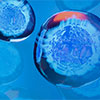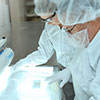BIOTIUM, INC
Supplier:
Biotium
Description:
This MAb recognizes cytokeratin 4, 5, 6, 8, 10, 13, and 18. This is a broad-spectrum antibody, which has been reported to differentiate epithelial tumors from non-epithelial tumors. Many studies have shown the usefulness of keratins as markers in cancer research and tumor diagnosis.
CF® dyes are Biotium's next-generation fluorescent dyes. CF®640R is a far-red fluorescent dye (Ex/Em 642/662 nm) with excellent brightness, and the best photostabiity among spectrally-similar dyes.
Supplier:
Biotium
Description:
This antibody recognizes a glycoprotein of 110 kDa, which is identified as CD68. It is important for identifying macrophages in tissue sections. It stains macrophages in a wide variety of human tissues, including Kupffer cells and macrophages in the red pulp of the spleen, in lamina propria of the gut, in lung alveoli, and in bone marrow. It reacts with myeloid precursors and peripheral blood granulocytes. It also reacts with plasmacytoid T cells, which are supposed to be of monocyte/macrophage origin. It shows strong granular cytoplasmic staining of chronic and acute myeloid leukemia and also reacts with rare cases of true histiocytic neoplasia. Lymphomas are negative or show few granules.
CF® dyes are Biotium's next-generation fluorescent dyes. CF®405M is a blue fluorescent dye (Ex/Em 408/452 nm) with superior brightness and photostability compared to other blue dyes; it is also compatible with super-resolution imaging by SIM. Note: Conjugates of blue fluorescent dyes are not recommended for detecting low abundance targets, because blue dyes have lower fluorescence and can give higher non-specific background than other dye colors.
Catalog Number:
(75918-038)
Supplier:
Biotium
Description:
CD71 Monoclonal antibody, Clone: 66IG10, Host: Mouse, Species reactivity: Human, Isotype: IgG2b, kappa, Conjugate: BSA-free, Immunogen: Human thymocytes (T-cells), Synonyms: Mtvr-1, p90, TFR1, TFRC transferrin receptor (p90 CD71), TRFR, Application: IF, FC, Size: 50uL
Supplier:
Biotium
Description:
This antibody recognizes a protein of 40 kDa, identified as CD7 (also known as gp40, Leu9). CD7 is a member of the immunoglobulin gene superfamily. Its N-terminal amino acids 1-107 are highly homologous to Ig kappa-L chains whereas the carboxyl-terminal region of the extracellular domain is proline-rich and has been postulated to form a stalk from which the Ig domain projects. CD7 is expressed on the majority of immature and mature T-lymphocytes, and T cell leukemia. It is also found on natural killer cells, a small subpopulation of normal B cells and on malignant B cells. Cross-linking surface CD7 positively modulates T cell and NK cell activity as measured by calcium fluxes, expression of adhesion molecules, cytokine secretion and proliferation. CD7 associates directly with phosphoinositol 3'-kinase. CD7 ligation induces production of D-3 phosphoinositides and tyrosine phosphorylation.
CF® dyes are Biotium's next-generation fluorescent dyes. CF®488A is a green fluorescent dye (Ex/Em 490/515 nm) with excellent brightness and photostability. The dye is minimally charged for less non-specific binding. CF®488A also is compatible with super-resolution imaging by TIRF.
Supplier:
Biotium
Description:
CD6 is a type I transmembrane glycoprotein that contains a 24-amino acid signal sequence, three extracellularscavenger receptor cysteine-rich(SRCR) domains, a membrane-spanning domain and a 44-amino acid cytoplasmic domain. The CD6 glycoprotein is tyrosine phosphorylated during TCR-mediated T cell activation. CD6 shows significant homology to CD5. CD6 is present on mature thymocytes, peripheral T cells and a subset of B cells. Antibodies to CD6 are used to deplete T cells from bone marrow transplants to prevent graft versus host disease.
CF® dyes are Biotium's next-generation fluorescent dyes. CF®405S is a blue fluorescent dye (Ex/Em 404/431 nm) with superior brightness compared to other blue dyes; it is also compatible with super-resolution imaging by SIM. Note: Conjugates of blue fluorescent dyes are not recommended for detecting low abundance targets, because blue dyes have lower fluorescence and can give higher non-specific background than other dye colors.
Supplier:
Biotium
Description:
Cytokeratin 18 Monoclonal antibody, Clone: C-04, Host: Mouse, Species reactivity: Hamster, Goat, Horse, Monkey, Pig, Dog, Cow, Cat, Sheep, Rat, Marmoset, Human, Ferret, Mouse, Isotype: IgG1, K, Conjugate: CF568, Immunogen: cell line A431, Size: 500 uL
Supplier:
Biotium
Description:
This antibody recognizes a protein of 30 kDa, identified as CD70. It is a cytokine that belongs to the tumor necrosis factor (TNF) ligand family. This cytokine is a ligand for TNFRSF27/CD27. It is a surface antigen on activated, but not on resting, T- and B-lymphocytes. It induces proliferation of co-stimulated T cells, enhances the generation of cytolytic T cells, and contributes to T cell activation. This cytokine is also reported to play a role in regulating B-cell activation, cytotoxic function of natural killer cells, and immunoglobulin synthesis.
CF® dyes are Biotium's next-generation fluorescent dyes. CF®640R is a far-red fluorescent dye (Ex/Em 642/662 nm) with excellent brightness, and the best photostabiity among spectrally-similar dyes.
Supplier:
Biotium
Description:
This antibody reacts with five invariable CD3 chains designated CD3y, CD3d, CD3e, CD3f, and CD3n with molecular weight ranging from 16-28 kDa. It is found on all mature T-lymphocytes, NK, T-cells, and some thymocytes. CD3, also known as T3, is a member of the immunoglobulin superfamily that plays a role in antigen recognition, signal transduction, and T cell activation. It is expressed, typically at high levels, on peripheral T cells and majority of T cell neoplasms. Thymocytes express CD3 at different level on the cell surface in the course of differentiation and, in cortical thymus, CD3 is predominantly intracytoplasmic. This MAb is particularly useful for induction of T cell activation in vitro and in vivo due to its unusual IgG3 isotype.
CF® dyes are Biotium's next-generation fluorescent dyes. CF®568 is a red fluorescent dye (Ex/Em 562/583 nm) with superior brightness and photostability. It also is compatible with super-resolution imaging by STORM and TIRF.
Supplier:
Biotium
Description:
CD43 Monoclonal antibody, Clone: DF-T1, Host: Mouse, Species reactivity: Human, Isotype: IgG1, kappa, Conjugate: CF568, Immunogen: Myeloblastic KG1 cells, Synonyms: GALGP, GPL115, Application: ImmunoFluorescence, IHC, Flow Cytometry, Size: 100uL
Supplier:
Biotium
Description:
CD43 Monoclonal antibody, Clone: SPN/1094, Host: Mouse, Species reactivity: Human, Isotype: IgG1, kappa, Conjugate: purified, Immunogen: Recom human SPN protein, Synonyms: GALGP, GPL115, Application: IF, IHC, FC, Size: 100uL
Supplier:
Biotium
Description:
CGA Monoclonal antibody, Clone: LK2H10, Host: Mouse, Species reactivity: Mouse, Monkey, Pig, Rat, Human, Isotype: IgG1, kappa, Conjugate: purified, Immunogen: Human pheochromocytoma, Synonyms: Beta-Granin, CGA, ER-37, Application: IF, IHC, FC, Size: 100uL
Supplier:
Biotium
Description:
CGA Monoclonal antibody, Clone: CHGA/765, Host: Mouse, Species reactivity: Human, Isotype: IgG1, kappa, Conjugate: CF640R, Immunogen: Recom human chromogranin A protein, Synonyms: Beta-Granin, CGA, ER-37, Application: IF, IHC, FC, Size: 500 uL
Supplier:
Biotium
Description:
Chromogranin A is present in neuroendocrine cells throughout the body, including the neuroendocrine cells of the large and small intestine, adrenal medulla and pancreatic islets. It is an excellent marker for carcinoid tumors, pheochromocytomas, paragangliomas, and other neuroendocrine tumors. Co-expression of chromogranin A and neuron specific enolase (NSE) is common in neuroendocrine neoplasms. Reportedly, co-expression of certain keratins and chromogranin indicates neuroendocrine lineage. The presence of strong anti-chromogranin staining and absence of anti-keratin staining should raise the possibility of paraganglioma. The co-expression of chromogranin and NSE is typical of neuroendocrine neoplasms. Most pituitary adenomas and prolactinomas readily express chromogranin.
CF® dyes are Biotium's next-generation fluorescent dyes. CF®640R is a far-red fluorescent dye (Ex/Em 642/662 nm) with excellent brightness, and the best photostabiity among spectrally-similar dyes.
Supplier:
Biotium
Description:
Twenty human keratins are resolved with two-dimensional gel electrophoresis into acidic (pI 6.0) subfamilies. This antibody cocktail recognizes acidic (Type I or LMW) and basic (Type II or HMW) cytokeratins, which 67 kDa (CK1); 64 kDa (CK3); 59 kDa (CK4); 58 kDa (CK5); 56 kDa (CK6); 52 kDa (CK8); 56.5 kDa (CK10); 50 kDa (CK14); 50 kDa (CK15); 48 kDa (CK16); 40 kDa (CK19). Many studies have shown the usefulness of keratins as markers in cancer research and tumor diagnosis. AE-1/AE-3 is a broad spectrum anti pan-cytokeratin antibody cocktail, which differentiates epithelial tumors from non-epithelial tumors e.g. squamous vs. adenocarcinoma of the lung, liver carcinoma, breast cancer, and esophageal cancer. It has been used to characterize the source of various neoplasms and to study the distribution of cytokeratin containing cells in epithelia during normal development and during the development of epithelial neoplasms. This antibody stains cytokeratins present in normal and abnormal human tissues and has shown high sensitivity in the recognition of epithelial cells and carcinomas.
CF® dyes are Biotium's next-generation fluorescent dyes. CF®405S is a blue fluorescent dye (Ex/Em 404/431 nm) with superior brightness compared to other blue dyes; it is also compatible with super-resolution imaging by SIM. Note: Conjugates of blue fluorescent dyes are not recommended for detecting low abundance targets, because blue dyes have lower fluorescence and can give higher non-specific background than other dye colors.
Supplier:
Biotium
Description:
CD99 Monoclonal antibody, Clone: MIC2/877, Host: Mouse, Species reactivity: Human, Isotype: IgG1, kappa, Conjugate: CF405S, Immunogen: Recom full-length human MIC2 protein, Synonyms: 12E7, E2 antigen, MIC 2X, MIC 2Y, MIC2, Application: IF, IHC, FC, Size: 500 uL
Supplier:
Biotium
Description:
CD99 Monoclonal antibody, Clone: MIC2/877, Host: Mouse, Species reactivity: Human, Isotype: IgG1, kappa, Conjugate: purified, Immunogen: Recom full-length human MIC2 protein, Synonyms: 12E7, E2 antigen, MIC 2X, MIC 2Y, MIC2, Application: IF, IHC, FC, Size: 500 uL
Inquire for Price
Stock for this item is limited, but may be available in a warehouse close to you. Please make sure that you are logged in to the site so that available stock can be displayed. If the
Stock for this item is limited, but may be available in a warehouse close to you. Please make sure that you are logged in to the site so that available stock can be displayed. If the
You must log in to order restricted items. We request that you provide the required business documentation to purchase this product for the first time.
To order chemicals, medical devices, or other restricted products please provide identification that includes your business name and shipping address via email CMD_NA@vwr.com or fax 484.881.5997 referencing your VWR account number . Acceptable forms of identification are:
-Additional Documentation May be needed to purchase this item. A VWR representative will contact you if needed.
This product has been blocked by your organization. Please contact your purchasing department for more information.
The original product is no longer available. The replacement shown is available.
This product is currently unavailable but limited stock may be available in our extended warehouse network. Please call 1-800-932-5000 and a VWR Customer Service Representative will help you.
|
|||||||||


































